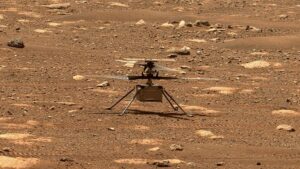How do we know if an asteroid headed our way is dangerous?
Sunday, 11 April 2021 09:15
There are a lot of things that pose a threat to our planet—climate change, natural disasters, and solar flares, for example. But one threat in particular often captures public imagination, finding itself popularised in books and films and regularly generating alarming headlines: asteroids.
In our solar system there are millions of space rocks known as asteroids. Ranging in size from a few metres to hundreds of kilometres, these objects are mostly left over from the formation of our planets 4.6 billion years ago. They are building blocks that didn't quite make it into fully fledged worlds.
Asteroids and other objects that make a closest approach to our sun of less than 1.3 astronomical units (1 astronomical unit, AU, is the Earth-Sun distance) are known as
Five things to know about Gagarin's journey to space
Sunday, 11 April 2021 08:23
Sixty years ago on Monday cosmonaut Yuri Gagarin became the first person in space, securing victory for Moscow in its race with Washington and marking a new chapter in the history of space exploration.
Decades later, his journey has become shrouded in myth after many details about the historic mission were for years kept secret by the Soviets.
Here are five things to know about Gagarin's legendary flight:
'Let's go!'
A trained steel worker turned military pilot, Gagarin was selected from thousands of candidates to undergo the rigorous training required for a space flight.
Apart from showing excellent results in his tests, Gagarin, then aged 27, also reportedly stood out by removing his shoes before entering the Vostok spacecraft designated for the mission, a custom in Russia when entering a home.
On April 12, 1961, as Gagarin's flight took off from the Baikonur spaceport in Kazakhstan, he exclaimed his iconic catchphrase "Poekhali!", or "Let's go!" in Russian.
Risky business
The flight lasted just 108 minutes as the Vostok completed one loop around the Earth.
Once Gagarin safely returned home, the success of his mission outshone the fact that not everything went according to plan.
Exolaunch entering orbital debris market with eco-friendly space tugs
Sunday, 11 April 2021 08:00
TAMPA, Fla. — German launch services provider Exolaunch is developing a line of eco-friendly space tugs called Reliant, designed to clean up debris after sending satellites to custom orbits.
Flight tests will start in the second half of 2022 on a SpaceX Falcon 9 rideshare mission with customer payloads, according to Exolaunch vice president of launch services Jeanne Medvedeva.
Soviet cosmonaut made pioneering spaceflight 60 years ago
Sunday, 11 April 2021 07:49
Coverage set for NASA's SpaceX Crew-2 Briefings, Events, Broadcasts
Saturday, 10 April 2021 14:27 NASA will provide coverage of the upcoming prelaunch and launch activities for the agency's SpaceX Crew-2 mission with astronauts to the International Space Station. This is the second crew rotation flight of the SpaceX Crew Dragon and the first with two international partners. The flight follows certification by NASA for regular flights to the space station as part of the agency's Commercial Cr
NASA will provide coverage of the upcoming prelaunch and launch activities for the agency's SpaceX Crew-2 mission with astronauts to the International Space Station. This is the second crew rotation flight of the SpaceX Crew Dragon and the first with two international partners. The flight follows certification by NASA for regular flights to the space station as part of the agency's Commercial Cr Rocket Lab to recover Electron Booster on next mission
Saturday, 10 April 2021 14:27 Rocket Lab reports that on its next mission the company will attempt to bring a rocket back from space, slowing the Electron launch vehicle down from speeds of >Mach 8 as it re-enter's Earth's atmosphere before splashing the rocket down in the ocean.
The complex mission is the next major step toward making Electron the first orbital-class reusable small launch vehicle, enabling rapid-turna
Rocket Lab reports that on its next mission the company will attempt to bring a rocket back from space, slowing the Electron launch vehicle down from speeds of >Mach 8 as it re-enter's Earth's atmosphere before splashing the rocket down in the ocean.
The complex mission is the next major step toward making Electron the first orbital-class reusable small launch vehicle, enabling rapid-turna Progress MS-16 docking in February failed due to nose cone issues
Saturday, 10 April 2021 14:27 A malfunction in the nose cone of the Soyuz launch vehicle led to an incident during the docking of Russia's Progress MS-16 cargo spacecraft to the International Space Station (ISS) in February, the general director of the Progress space rocket centre, Dmitry Baranov, said on Saturday.
"The commission will work until 30 April. The problem is in the nose cone", Baranov told reporters.
A malfunction in the nose cone of the Soyuz launch vehicle led to an incident during the docking of Russia's Progress MS-16 cargo spacecraft to the International Space Station (ISS) in February, the general director of the Progress space rocket centre, Dmitry Baranov, said on Saturday.
"The commission will work until 30 April. The problem is in the nose cone", Baranov told reporters. Acting NASA Administrator Statement on Agency FY 2022 Discretionary Request
Saturday, 10 April 2021 14:27 The Biden-Harris Administration submitted to Congress Friday the president's priorities for fiscal year 2022 discretionary spending. The following is a statement from acting NASA Administrator Steve Jurczyk on the funding request:
"This $24.7 billion funding request demonstrates the Biden Administration's commitment to NASA and its partners who have worked so hard this past year under diff
The Biden-Harris Administration submitted to Congress Friday the president's priorities for fiscal year 2022 discretionary spending. The following is a statement from acting NASA Administrator Steve Jurczyk on the funding request:
"This $24.7 billion funding request demonstrates the Biden Administration's commitment to NASA and its partners who have worked so hard this past year under diff CO2 mitigation on Earth and magnesium civilization on Mars
Saturday, 10 April 2021 14:27 Excessive CO2 emissions are a major cause of climate change, and hence reducing the CO2 levels in the Earth's atmosphere is key to limit adverse environmental effects. Rather than just capture and store CO2, it would be desirable to use it as carbon feedstock for fuel production to achieve the target of "net-zero-emissions energy systems".
The capture and conversion of CO2 (from fuel gas o
Excessive CO2 emissions are a major cause of climate change, and hence reducing the CO2 levels in the Earth's atmosphere is key to limit adverse environmental effects. Rather than just capture and store CO2, it would be desirable to use it as carbon feedstock for fuel production to achieve the target of "net-zero-emissions energy systems".
The capture and conversion of CO2 (from fuel gas o The European Hexa-X project for the development of 6G technology starts
Saturday, 10 April 2021 14:27 The Universidad Carlos III de Madrid (UC3M) is participating in the development of the European Hexa-X project, through the Network Technologies research group and coordinated by Nokia, to promote the development of technologies that will make up 6G from Europe.
This project, funded by the European Commission within the framework of the Horizon 2020 research and innovation programme, also
The Universidad Carlos III de Madrid (UC3M) is participating in the development of the European Hexa-X project, through the Network Technologies research group and coordinated by Nokia, to promote the development of technologies that will make up 6G from Europe.
This project, funded by the European Commission within the framework of the Horizon 2020 research and innovation programme, also Amounts of organic molecules in planetary systems differ from early on
Saturday, 10 April 2021 14:27 An international group of scientists led by the RIKEN Cluster for Pioneering Research have studied the chemical composition of 50 protoplanetary-disk forming regions in the Perseus Molecular Cloud, and found that despite being in the same cloud, the amounts of complex organic molecules they contain are quite different. Interestingly, the chemically rich young disks have similar compositions of o
An international group of scientists led by the RIKEN Cluster for Pioneering Research have studied the chemical composition of 50 protoplanetary-disk forming regions in the Perseus Molecular Cloud, and found that despite being in the same cloud, the amounts of complex organic molecules they contain are quite different. Interestingly, the chemically rich young disks have similar compositions of o Long-awaited review reveals journey of water from interstellar clouds to habitable worlds
Saturday, 10 April 2021 14:27 Dutch astronomer Ewine van Dishoeck (Leiden University, the Netherlands), together with an international team of colleagues, has written an overview of everything we know about water in interstellar clouds thanks to the Herschel space observatory.
The article, published in the journal Astronomy and Astrophysics, summarizes existing knowledge and provides new information about the origin of
Dutch astronomer Ewine van Dishoeck (Leiden University, the Netherlands), together with an international team of colleagues, has written an overview of everything we know about water in interstellar clouds thanks to the Herschel space observatory.
The article, published in the journal Astronomy and Astrophysics, summarizes existing knowledge and provides new information about the origin of NASA delays Mars copter flight for tech check
Saturday, 10 April 2021 03:32 NASA has delayed by at least several days the first flight of its mini-helicopter on Mars after a possible tech issue emerged while testing its rotors, the US space agency said Saturday.
Ingenuity's trip, which is to be the first-ever powered, controlled flight on another planet, was set for Sunday but is now on hold until at least April 14.
A high-speed test of the four-pound (1.8 kilo
NASA has delayed by at least several days the first flight of its mini-helicopter on Mars after a possible tech issue emerged while testing its rotors, the US space agency said Saturday.
Ingenuity's trip, which is to be the first-ever powered, controlled flight on another planet, was set for Sunday but is now on hold until at least April 14.
A high-speed test of the four-pound (1.8 kilo NASA delays first flight of Mars helicopter
Friday, 09 April 2021 21:03
WASHINGTON — NASA announced April 10 it was postponing the first flight attempt of the Ingenuity helicopter on Mars by at least three days after detecting a problem during a final pre-flight test.
In a brief statement, NASA said that the command sequence for an April 9 test of the vehicle’s rotors, where they would spin up to full speed, ended early when a “watchdog” timer expired.
General Atomics wins DARPA contract to design nuclear reactor to power missions to the moon
Friday, 09 April 2021 10:56
WASHINGTON — The Defense Advanced Research Projects Agency awarded a $22 million contract to General Atomics to design a small nuclear reactor for space propulsion, the agency announced April 9.
General Atomics, based in San Diego, California, was selected for the first phase of a program known as a DRACO, short for demonstration rocket for agile cislunar operations.

